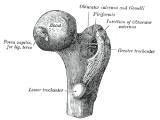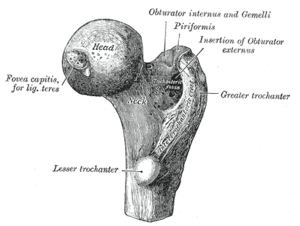
Femoral head ostectomy
Encyclopedia

History
FHO was first described by Gathorne Robert Girdlestone(1881–1950) in 1945. He originally designed the procedure for treating tuberculosisTuberculosis
Tuberculosis, MTB, or TB is a common, and in many cases lethal, infectious disease caused by various strains of mycobacteria, usually Mycobacterium tuberculosis. Tuberculosis usually attacks the lungs but can also affect other parts of the body...
and other disorders of the hips. This has led to the procedure also being known as a "Girdlestone operation". Other surgeons added various modifications to the procedure to improve recovery and outcomes.
FHO was first described in veterinary science in 1961 by J.S.A. Spreull. It can be suggested however that the technique was developed concurrently at other locations.
Indications in veterinary science
Small breeds of dog, cats and small horses, donkeys and ponies have all had the procedure performed successfully.Hip dysplasia, an extremely painful congenital condition found in many dog breeds and some cats, is an example of such a condition where this procedure may be used. It is also performed in cases of trauma where the head of the femur is badly broken or severed, or in response to other diseases of the hip bone, such As Legg-Calve-Perthes' disease. It is sometimes the procedure of last resort when other methods have failed and or sepsis of the joint has occurred, but it can be indicated when the hip joint is severely affected or if arthritis In the joint is serious enough. It can also be indicated in small animals with pelvic fractures, particularly fractures of the acetabulum
Acetabulum
The acetabulum is a concave surface of the pelvis. The head of the femur meets with the pelvis at the acetabulum, forming the hip joint.-Structure:...
(socket of the pelvis).
Procedure
The procedure exposes the head section of the femurFemur
The femur , or thigh bone, is the most proximal bone of the leg in tetrapod vertebrates capable of walking or jumping, such as most land mammals, birds, many reptiles such as lizards, and amphibians such as frogs. In vertebrates with four legs such as dogs and horses, the femur is found only in...
bone (the ball of the ball and socket joint), and then the head is removed using a small saw or a bone hammer and chisel. Rarely both sides are done in one operation, most times one side is done and allowed to heal before the other side is done.
Unlike most other hip surgeries, the head of the femur is not replaced, but is allowed to heal and develop its own fibrous scar tissue so that the joint is no longer bone−to-bone, a pseudoarthrosis (also called a "false joint"). The neck of the femur is usually removed at the same time as the head. This prevents the post operative complication of bone rubbing on bone and continued pain. This has led to the procedure often also called "Femoral head and neck ostectomy".
Animals who have had FHO surgery are required to maintain a lower weight throughout their lives to compensate for the loss of skeletal integrity, and generally have less mobility than normal.
Other species
Small horses and ponies can have an ostectomyOstectomy
An Ostectomy is a procedure involving the removal of bone.An example is femoral head ostectomy.In dentistry, ostectomy refers specifically to the removal of bone surrounding a tooth in an attempt to eliminate an adjacent periodontal pocket.-References:...
without an osteotomy
Osteotomy
An osteotomy is a surgical operation whereby a bone is cut to shorten, lengthen, or change its alignment. It is sometimes performed to correct a hallux valgus, or to straighten a bone that has healed crookedly following a fracture. It is also used to correct a coxa vara, genu valgum, and genu varum...
of the greater trochanter
Greater trochanter
The greater trochanter of the femur is a large, irregular, quadrilateral eminence and a part of the skeletal system.It is directed a little lateralward and backward, and, in the adult, is about 1 cm lower than the head...
. As a salvage procedure, this is usually performed in those animals which have the specific injury of a fracture of the capital physis. These patients would not return to function as a riding horse and the procedure may be performed for those animals involved in breeding, milking, and being kept as companion animals.

